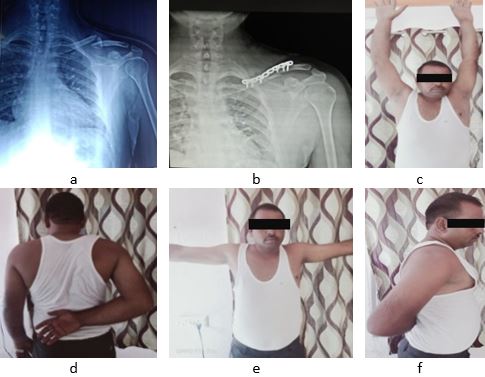Introduction
Clavicular fracture accounts for approximately 5% to 10% of all fractures and up to 44% of injuries to the shoulder girdle [1,2]. About 70% to 80% of these fractures are in the middle third of the bone, followed by the lateral third (12% to 15%) and the medial third (5% to 8%) [3-5]. This higher incidence is because midshaft clavicle has the thinnest segment of bone which is not stabilized by ligaments [6-8].
A direct blow on the shoulder is the commonest mode of injury that causes fracture of the clavicle. These clavicle fractures have been traditionally treated non-operatively, which has shown poor outcomes with increased rate of malunion and nonunion [6,8-10].
Operative fixation of clavicle fracture prevents these complications and provides increased patient satisfaction, early pain relief, rehabilitation and better functional outcome [11]. Recent studies have reported high success rates after primary operative fixation with union rates ranging from 94% to 100% and low rates of infection and surgical complications [12,13]. To validate this better functional outcome of clavicle fracture with surgical treatment we evaluated the outcome of locking compression plate in treatment of comminuted middle third clavicular fractures.
Material and Methods
This study was conducted in our institute between Dec 2017 to Dec 2019 on 25 patients of mid-third clavicular fracture, attending our emergency or OPD department. Institutional ethical committee approval and informed written consent from all the patients was obtained. Closed comminuted middle third clavicular fracture patients aged between 18 to 60 years with no medical contraindication for surgery were included in the study. Skeletally immature patient, open or pathological fracture and associated with other injuries were excluded from the study.
Plain radiograph of clavicle along with shoulder in antero-posterior view was taken to assess the site and type of fracture. Routine investigations were done and fitness for surgery was obtained. All patients were operated in supine position under general anesthesia via anterior approach fixing the fractured middle third clavicle with appropriate size locking compression plate. Postoperatively, analgesic and antibiotics were continued, with dressing on 2nd day and suture removal at 2 weeks was done.
The involved limb was supported by arm pouch. Intermittent exercises, with gentle pendulum exercises were started from 3rd day. Gradually full active range of motion in all the planes was achieved till 4 to 6 weeks. Patients were followed regularly at 2, 4, 8 and 12 weeks and monthly thereafter. Patients were assessed clinically as well as radiologically. X-rays were taken at each follow-up to see progressive fracture union and implant position. The functional outcome was assessed by Constant and Murley score [14].
Results
25 patients of comminuted midshaft clavicle fracture, with mean age 28.3 years (range 21 to 44) were included in study, of which 20 patients (80%) were male and 5 (20%) were females. 18 patients (72%) had left sided fracture, whereas 7 patients (28%) had right sided fracture.
10 patients (40%) sustained trauma due to fall on outstretched hand and 15 (60%) were due to road traffic accident. All patients except one were operated within 5 days after the injury, whereas one patient was operated with delay of 8 days after injury.
All fractures united at mean duration on 13.2 weeks, with 20(80%) patients united at 12 weeks and 5(20%) patients united at 15 weeks. As per Constant and Murley score, 18 patients (72%) had excellent functional outcome, good in 5 patients (20%), fair in 2 patients (8%) and none of the patients had poor outcome (fig 1).
03 patients (12%) developed hypertrophic skin scar and in 2 patients (8%) plate prominence occurred. 1 patient (4%) had superficial infection, which healed after antibiotics.
Figure 1:Pre operative (a) and immediate post-operative (b) antero-posterior x rays of a 40 years’ male with clavicle fracture who was operated with locking plate. 6 months follow up clinical pictures showing excellent functional outcome (c to f).

Discussion
Clavicle fractures are among the most common fractures of young age group, which account for 5% of all fractures and 44% of all shoulder fracture injury [1,2]. Middle third is most common involved followed by lateral and medial third [3-5]. High failure rates of conventional conservative treatment, along with increased understanding of fracture biomechanics of clavicle, had led to conclude that operative surgical management, especially for fractures with comminution, gross displacement or shortening > 2 cm leads to good functional outcome and early mobilization of patients [12,13,15].



